
How Amare came to be
Did you know that the story of Amare starts all the way back in 2009? Fold out the years in this timeline to read more about the process of designing and building the new culture complex at Spuiplein.
2009
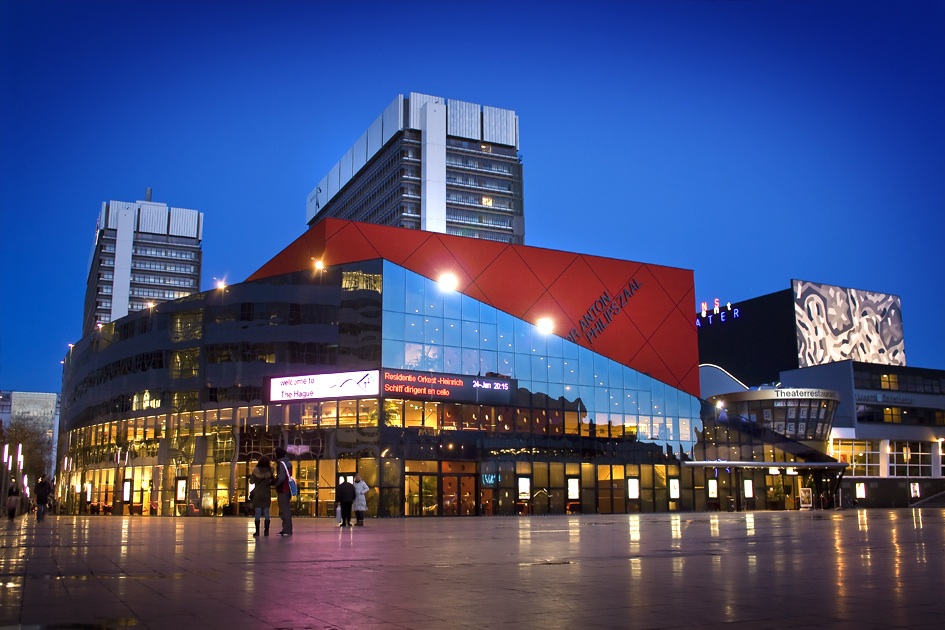
Dr Anton Philipszaal and Lucent Danstheater on the Spuiplein © Claire Droppert
The Dr Anton Philipszaal and the Lucent Danstheater were built in 1987, with minimal financial resources – just 45 million guilders, which amounts to approximately 21 million euros. The buildings received something of a patch-up twenty years later, but it is clear at that point that more extensive repairs are required. This creates a bit of a dilemma: to opt for a thorough renovation, or a demolition and new build? In 2009, the City of the Hague settles on new build, as this would better meet modern requirements and provides an opportunity for sustainable construction. Furthermore, many people wish to see the Royal Conservatoire return to the city centre. Construction is expected to be completed by 2018.
2010
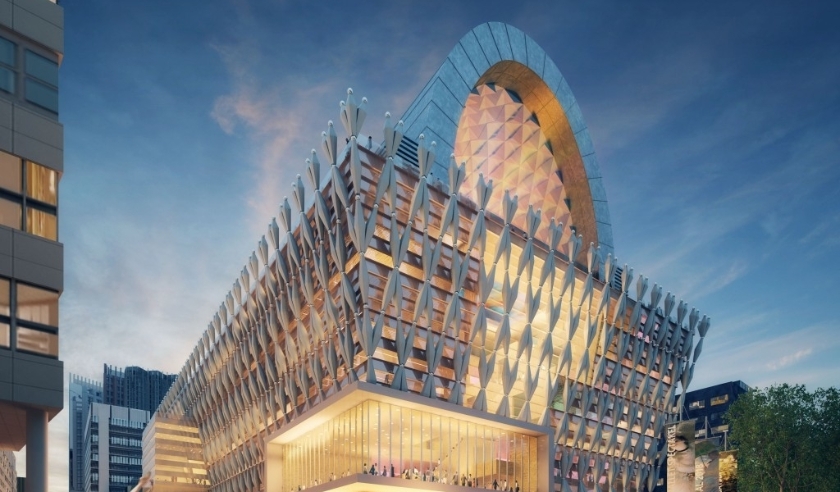
Impression of Spuiforum design by Neutelings Riedijk Architecten. Image source: De Architect
The Municipal Council commissions the Office for Metropolitan Architecture (OMA) to formulate an urban development vision and announces a design competition. Of the sixteen entries, three are shortlisted for further elaboration. Neutelings Riedijk Architecten eventually defeats competitors Zaha Hadid and RAU to win the contract.
Architect Willem Jan Neutelings talks about the design of the Spuiforum (in Dutch):
2011
The development of Spuiforum is delayed by a year due to the economic crisis and insufficient support within the Municipal Council. At the Council’s request, Neutelings Riedijk Architecten modifies the design in order to limit the costs. One of those adjustments involves rotating the design, sparking criticism from the architects responsible for the two distinctive existing buildings on Spui, Herman Hertzbergen (Theater aan het Spui) and Richard Meier (The Hague City Hall).
2012
The Municipal Council votes in favour of the construction of Spuiforum, but many within the Council and the city continue to oppose the building, led by Werkgroep Dooievaar. The economic crisis has yet to abate.
2014
The newly elected Municipal Council decides to completely cancel the Spuiforum project and to reconsider the development of the area.
2015

Impression of Amare. Image source: NOAHH | Network Oriented Architecture and Jo Coenen Architects & Urbanists
The City of The Hague launches a call for tender, seeking a single party to handle the design, construction and maintenance of a new building. The contract is awarded to Cadanz (Boele & van Eesteren | Visser & Smit Bouw). In August, the affiliated architecture firms NOAHH | Network Oriented Architecture and Jo Coenen Architects & Urbanists present a new design for the Onderwijs- en Cultuurcomplex (Education and Culture Complex), or OCC. The design is 125 metres long, 70 metres wide and 38 metres tall, with four halls.
%20low%20res.jpg)
Zuiderstrandtheater © Maurice Haak
In September 2015, Zuiderstrandtheater opens in the port of Scheveningen as a temporary replacement for the Dr. Anton Philipszaal and Lucent Danstheater. It is a hall with 1,000 seats that will host concerts by the Residentie Orkest, the performances of Nederlands Dans Theater and some 250 further concerts and performances per season until the opening of the OCC, which is expected to take place in 2019.
The demolition of the Dr Anton Philipszaal and the Lucent Danstheater starts in October of 2015. The stage and wings of the Lucent Danstheater are left intact for the time being, and will continue to serve as rehearsal and office space for Nederlands Dans Theater until late 2021.
2017
The end of June 2017 is marked by a celebration of the beginning of construction on the Onderwijs- en Cultuurcomplex on Spui, although the real work has already been underway for a few months. After months of planning, construction on the OCC has finally begun.
Meanwhile, Zuiderstrandtheater is developing into an enormously popular, if temporary, theatre in the region of The Hague.
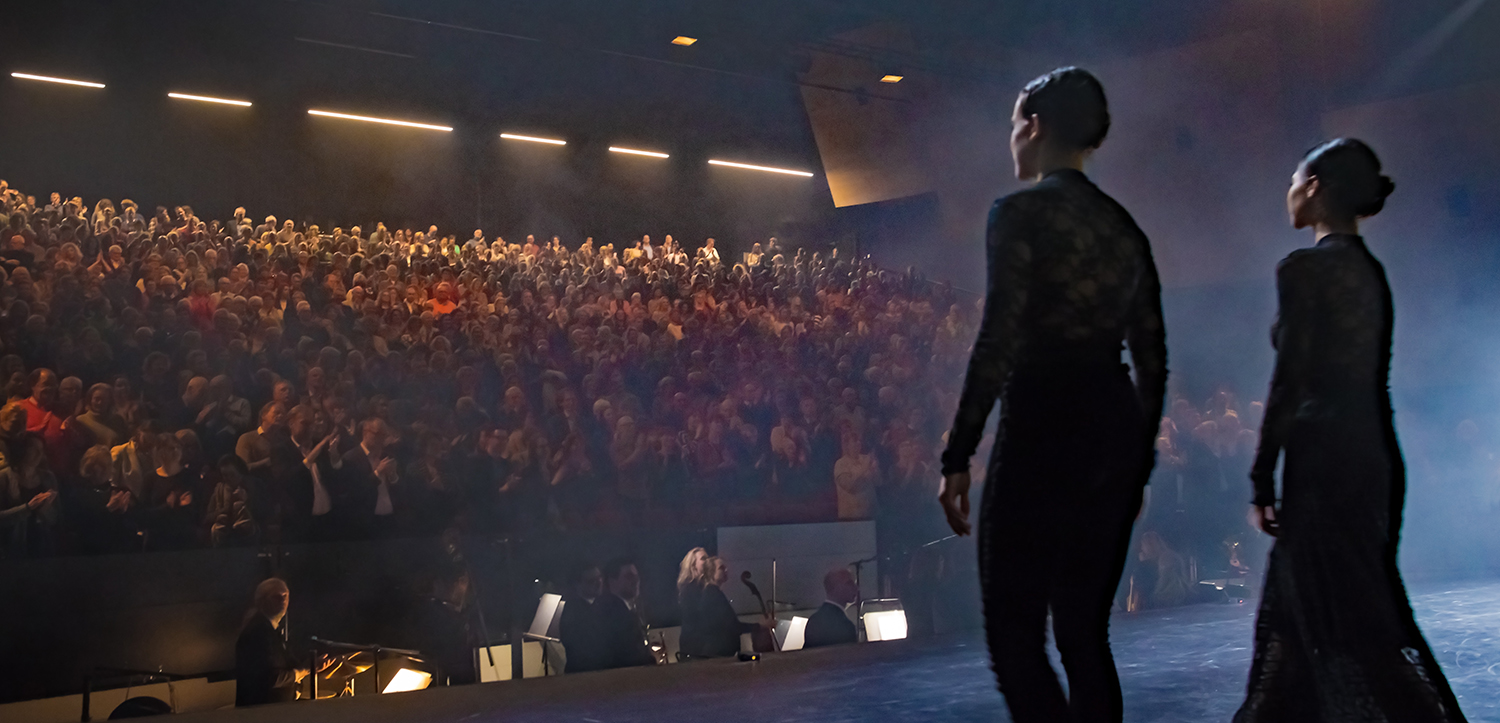
Scapino Ballet Rotterdam at Zuiderstrandtheater © Maurice Haak
Throughout the building process, construction consortium Cadanz (Boele & van Eesteren | Visser & Smit Bouw) created time lapses to give a bird’s eye view of the progress towards delivering Amare.
Timelapse construction of Amare June - December 2017
2018
Construction is progressing steadily. This time-lapse from January to June 2018 shows how the halls are built. On 28 August, the first tuning fork-shaped column is placed.
Timelapse January - June 2018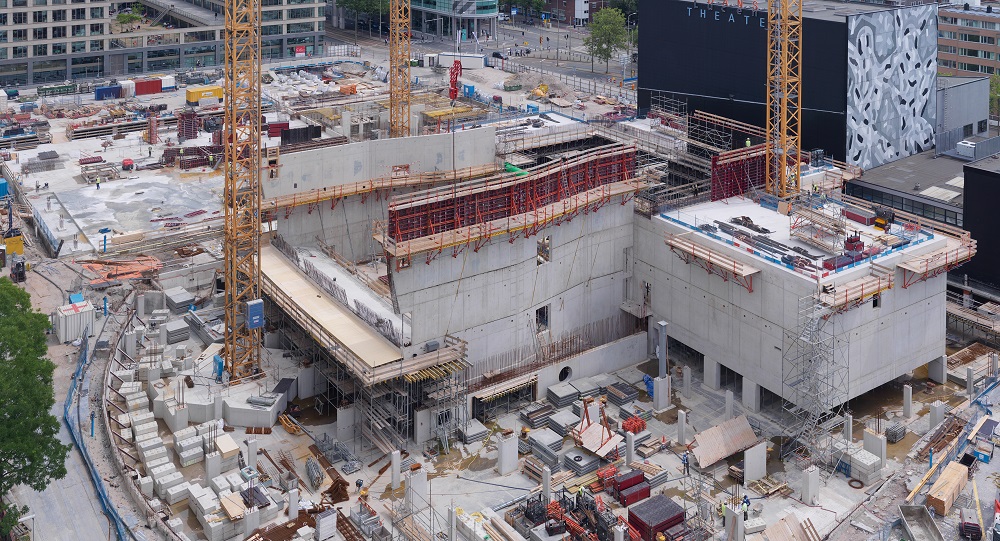
Construction is halfway through © Cadanz
2019
Almost two years after the start of construction, the outlines of the Onderwijs- en Cultuurcomplex are clearly visible. On 8 April 2019, construction reaches the halfway point.
Topping out
On 9 May 2019, in keeping with tradition, the builders celebrate reaching the building’s highest point with pannenbier (literally: roof tile beer)!
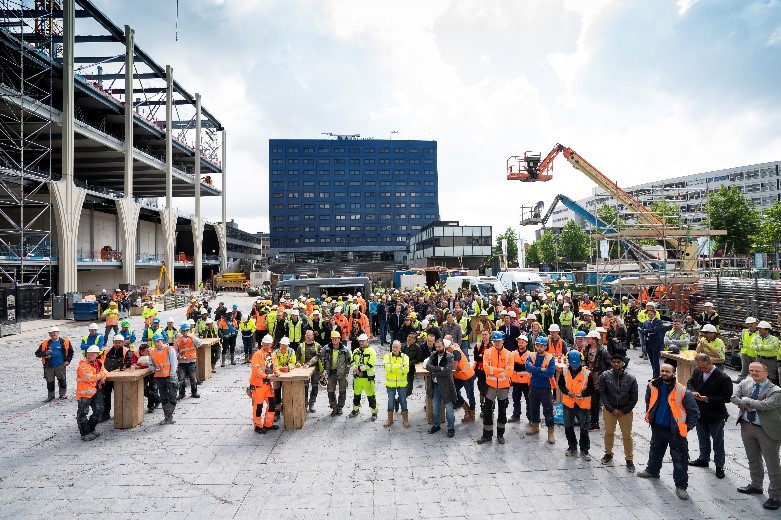
Topping out. Photo: Marijn Beekman
Construction Day
During the Dag van de Bouw (Construction Day) on 17 June 2019, the constructors organise an extensive tour of the OCC. The first 1500 visitors are treated to guided tours, performances and unique 3D visualisations of the Theaterzaal and the Concertzaal. The visitors are particularly impressed with how the Concertzaal is essentially suspended inside the building for acoustical reasons.
Timelapse January - June 2019. The construction of Onderwijs- en Cultuurcomplex. Source: Gemeente Den Haag
Announcement name Amare
Behind the scenes, the four future occupants – Zuiderstrandtheater, Royal Conservatoire, Nederlands Dans Theater and Residentie Orkest – work together to flesh out the Onderwijs- en Cultuurcomplex, from the internal logistics to the installations, interior furnishing and future programming. One of the first tangible results is the choice to name the complex Amare, which is announced on 10 October.
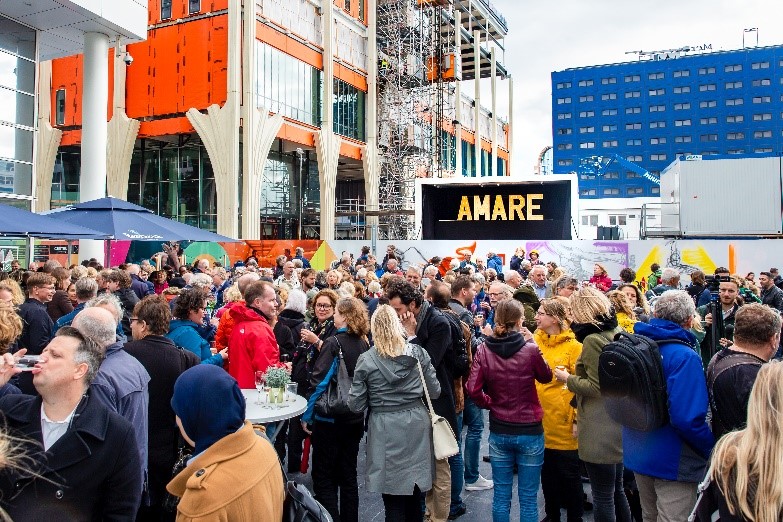
From 10 October 2019 on, the Onderwijs- en Cultuurcomplex is known as Amare. Photo: Anne Reitsma
In June 2019, the Municipal Council approves the Zuiderstrandtheater’s business plan for Amare.
2020
Henk Scholten, director of Stichting Dans- en Muziekcentrum Den Haag (the official name of Zuiderstrandtheater), reaches retirement age and, after 8 years with the organisation, takes leave at the end of January. He played an important role in the plans for the Spuiforum and, later, OCC/Amare. Scholten was also the spiritual father of Zuiderstrandtheater. He is succeeded by Jan Zoet, who served previously as director of Amsterdam’s Academy of Theatre and Arts and of the Rotterdamse Schouwburg, and is also the chairman of Kunsten ’92.
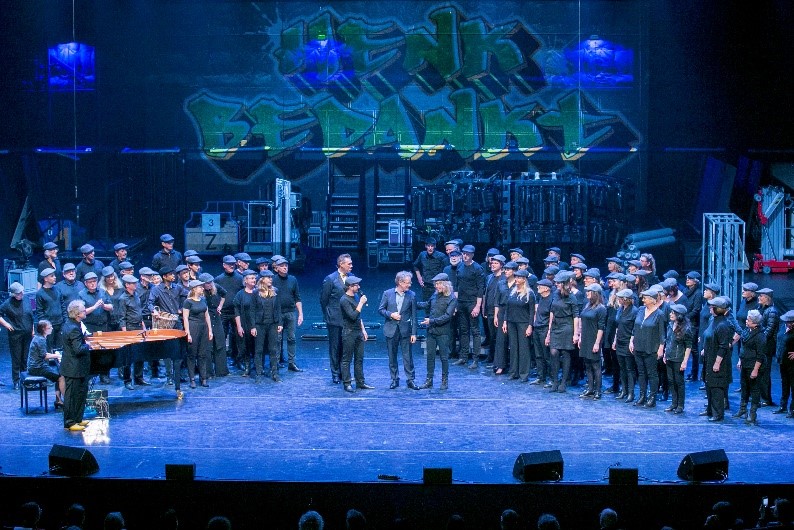
Taking leave of Zuiderstrandtheater director Henk Scholten. Photo: Wen van Gampelaere
In March 2020, the COVID-19 pandemic reaches the Netherlands. Fortunately, this does not delay the construction process, though it does mean that Construction Day is cancelled.
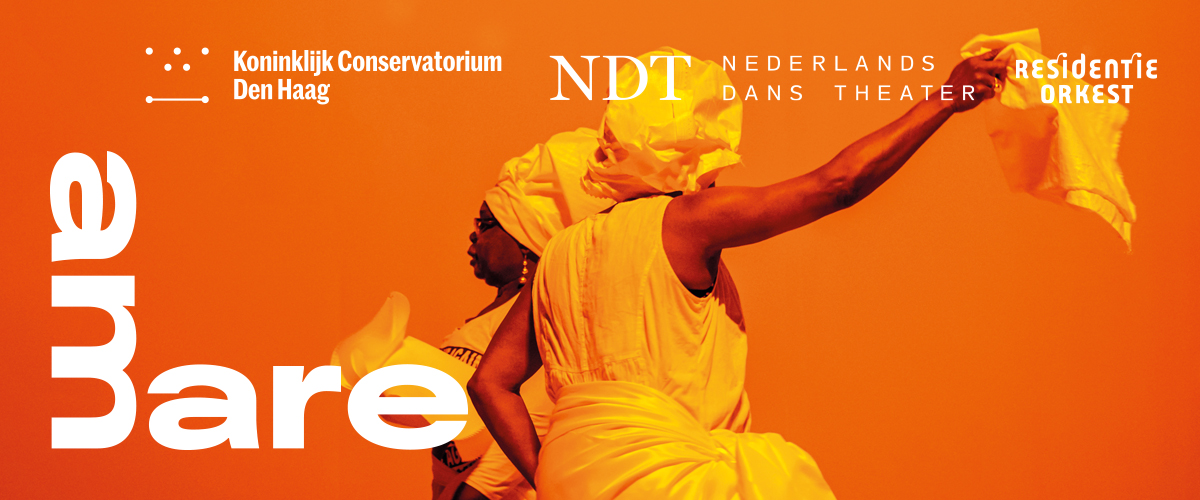
Amare’s house style is finalised in June 2020. Of the twelve candidates, design agency Silo was the clear winner. It subsequently designed the visual identity of Amare in collaboration with its resident organisations.
Zuiderstrandtheater launches Amare’s renewed website in November 2020.
Amare’s characteristic golden-yellow seating was installed in December 2020. The fly tower has also been mounted in the roof. Prominent theatre halls around the world feature such an installation, with which decor pieces and sometimes actors, too, can be hoisted up into the stage tower, out of the audience’s sight. 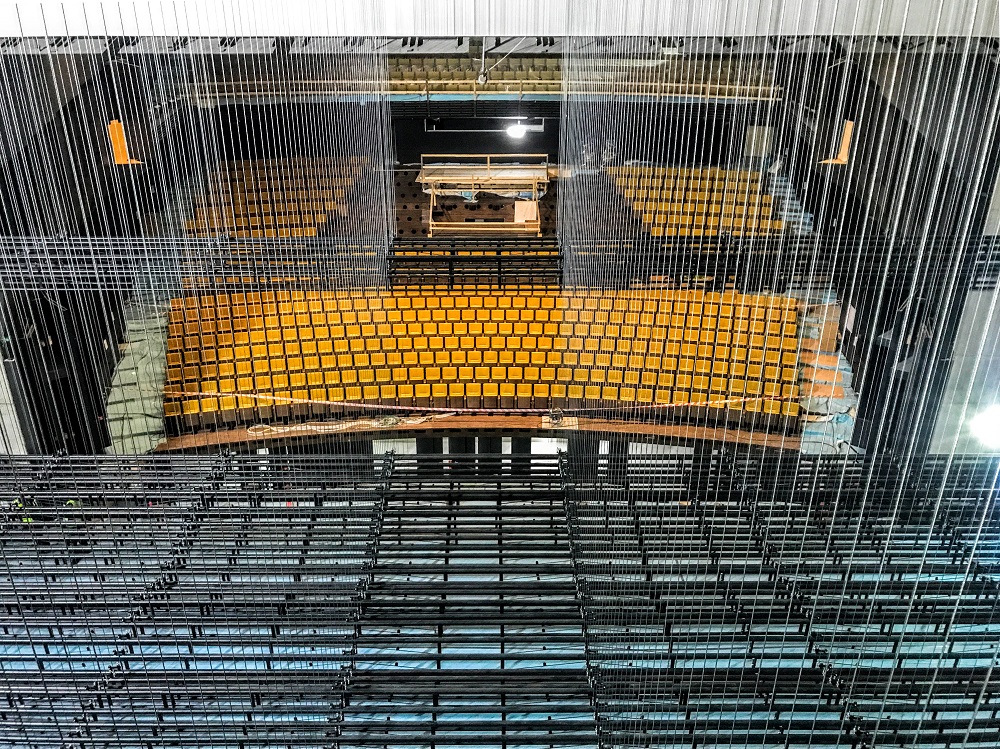
Amare's theatre hall with fly tower. Photo: Martin de Winter, Pelsuma bouwtoezicht
2021
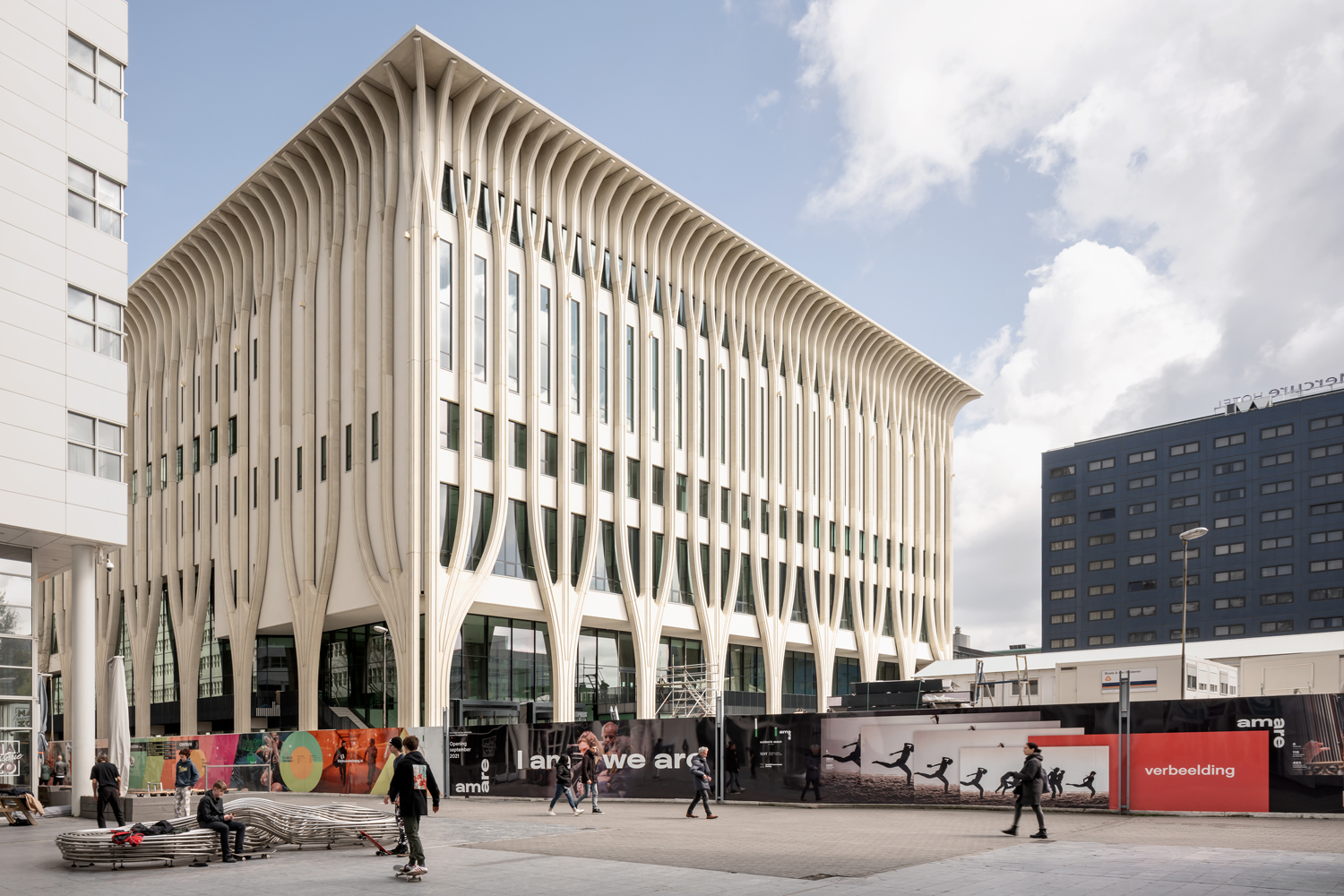
Amare in May 2021 © Katja Effting
In June 2021, ticket sales start for the majority of the performances and concerts for the 2021-2022 season.
On Thursday evening, 2 September, His Royal Highness King Willem-Alexander and Her Majesty Queen Máxima attend the festive handover of Amare. The City of The Hague on this evening formally hands over Amare to its four occupants. Read more about the Royal Visit.
Amare first opens its doors to the public on 4 and 5 September during the Open House. Over 5000 visitors come to Amare to have a first look.
Currently, Amare is open for the first (try-out) performances, concerts and guided tours.
Starting November 19, the season opens with an opening weekend. Despite the corona measures, the four resident companies of Amare present a welcoming introductory programme with dance, classical music and pop artists from The Hague. Amare is open!

